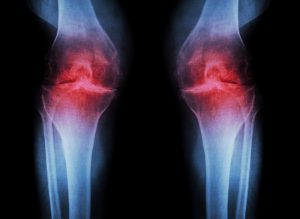Diseases January 10th, 2020
ជម្ងឺរលាកសន្លាក់

ជម្ងឺរលាកសន្លាក់ និង ស្តឹមសែល
តើអ្វីទៅជាជំងឺរលាកសន្លាក់ឆ្អឹង?
 ជំងឺរលាកសន្លាក់ឆ្អឹងត្រូវបានគេស្គាល់ផងដែរថាជា ជំងឺឆ្អឹងនិងឆ្អឹងខ្ចីត្រង់សន្លាក់, ជំងឺរលាកសន្លាក់ឆ្អឹងដោយសាការរលាកនិងការបាត់បង់ឆ្អឹងខ្ចី ជំងឺរលាកសន្លាក់ចាស់, ដែលជួនកាលត្រូវបានគេស្គាល់ជាទូទៅថា “ការកើនឡើងចំនួនកោសិការបស់ឆ្អឹងឬហើមឆ្អឹង” ។
ជំងឺរលាកសន្លាក់ឆ្អឹងត្រូវបានគេស្គាល់ផងដែរថាជា ជំងឺឆ្អឹងនិងឆ្អឹងខ្ចីត្រង់សន្លាក់, ជំងឺរលាកសន្លាក់ឆ្អឹងដោយសាការរលាកនិងការបាត់បង់ឆ្អឹងខ្ចី ជំងឺរលាកសន្លាក់ចាស់, ដែលជួនកាលត្រូវបានគេស្គាល់ជាទូទៅថា “ការកើនឡើងចំនួនកោសិការបស់ឆ្អឹងឬហើមឆ្អឹង” ។
ជាទូទៅដោយសារតែអាយុ ភាពធាត់ ការបន្ទាញខ្លាំង ការប៉ះទង្គិច និងកត្តាដទៃទៀតដែលបណ្តាលមកពីការថមថយនៃឆ្អឹងខ្ចី គាមសន្លាក់ រួមនិងការកើនឡើងនៃកោសិកាឆ្ឆ្អឹងស្រទាប់ខាងក្រោម។ រោគសញ្ញាគ្លីនិកបង្ហាញឡើងដោយ ការឈឺសន្លាក់បន្តិចម្តងៗ ការឈឺចាប់សន្លាក់និងគាំងសន្លាក់ មានទឹកដក់ក្នុងសន្លាក់ ការហើមសន្លាក់ មានការថយចុះនៃចលនាសន្លាក់ និងការខូចទ្រង់ទ្រាយសន្លាក់។
ការប៉ះពាល់ដ៏សំខាន់បំផុតចំពោះរាងកាយមនុស្សគឺការឈឺសន្លាក់ជង្គង់ដែលធ្វើឱ្យពិបាកក្នុងការឡើងចុះជណ្តើរនិងការលំបាកក្នុងការអង្គុយ។ ការអភិវឌ្ឍន៍នេះក៏នឹងជះឥទ្ធិពលដល់ការដើរនៅលើដីផងដែរ។ វាគឺជាជំងឺមួយក្នុងចំណោមអត្រាមានពិការភាពខ្ពស់បំផុតក្នុងមនុស្សវ័យកណ្តាលនិងចាស់។
អ្នកជំងឺមួយចំនួនមានសម្លេងកកិតឬ “សម្លេងក្រឹបៗ” នៅពេលពួកគេមានចលនា។ ក្នុងករណីធ្ងន់ធ្ងរពួកគេអាចមានការស្វិតសាច់ដុំនិងខូចទ្រង់ទ្រាយសន្លាក់។ វាបានបណ្តាលឱ្យមានការរំខានយ៉ាងខ្លាំងចំពោះជីវិតរបស់មនុស្សវ័យកណ្តាលនិងមនុស្សចាស់ដែលពួកគាត់ចូលចិត្តធ្វើដំណើរ។ ប្រសិនបើយើងធ្វើការថតដោយប្រើកាំរស្មីអ៊ិចចំពោះមនុស្សចាស់នោះ អ្នកនឹងឃើញថាអត្រានៃជំងឺរលាកសន្លាក់ឆ្អឹងចំពោះមនុស្សដែលមានអាយុលើសពី 50 ឆ្នាំគឺប្រហែល 50% ពោលគឺប្រហែលពាក់កណ្តាលនៃមនុស្សចាស់មានជំងឺរលាកសន្លាក់ឆ្អឹង ប៉ុន្តែតាមការពិតវាច្រើនជាងនេះទៅទៀត។ រោគសញ្ញាដែលបណ្តាលឱ្យពិបាកដើរមិនមានច្រើននោះទេ។ ការព្យាបាលដ៏សំខាន់សម្រាប់ជំងឺនេះគឺដើម្បីការបន្ថយទំងន់ទៅលើសន្លាក់ និងបន្ថយសកម្មភាពហួសប្រមាណ ដើម្បីពន្យាពេលការវិវត្តនៃជំងឺនេះ។ អ្នកជំងឺធាត់គួរសម្រកទម្ងន់និងកាត់បន្ថយទម្ងន់លើសន្លាក់។ នៅពេលជង្គង់មានសភាពធ្ងន់ធ្ងរ ឈើឆ្ពាមឬឈើជ្រាត់ អាចត្រូវបានប្រើដើម្បីកាត់បន្ថយទម្ងន់លើសន្លាក់។ បច្ចុប្បន្នមិនមានការព្យាបាលវេជ្ជសាស្រ្តណាមួយល្អនោះទេ។ ថ្នាំការពារសន្លាក់ ដូចជា glucosamine sulfate និង diacerein អាចត្រូវបានគេព្យាយាមប្រើដើម្បីគ្រប់គ្រងការរលាក ប៉ុន្តែលទ្ធផលគឺមិនច្បាស់លាស់។ នៅក្នុងករណីកម្រិតខ្ពស់អ្នកដែលមានការខូចទ្រង់ទ្រាយសន្លាក់និងខូចមុខងារសន្លាក់ ការព្យាបាលតំរួវអោយមានការវះកាត់។ ជាទូទៅមិនមានការព្យាបាលល្អសម្រាប់ជំងឺរលាកសន្លាក់ឆ្អឹងទេ។
ដំណាក់កាលនៃជំងឺរលាកសន្លាក់ឆ្អឹង
ជំងឺរលាកសន្លាក់ឆ្អឹង (OA) ត្រូវបានបែងចែកជា 5 ដំណាក់កាល។ ដំណាក់កាលទី 0 ត្រូវបានគេចាត់ឱ្យទៅជាជង្គង់ធម្មតាដែលមានសុខភាពល្អ។ ដំណាក់កាលខ្ពស់បំផុតគឺ 4 ត្រូវបានគេកំណត់ឱ្យ OA ធ្ងន់ធ្ងរ។ OA ដែលបានក្លាយទៅជាកម្រិតខ្ពស់នេះទំនងជាធ្វើឱ្យមានការឈឺចាប់យ៉ាងខ្លាំងនិងធ្វើឱ្យរំខានដល់ចលនាសន្លាក់។
ដំណាក់កាលទី 0
ដំណាក់កាល 0 ជំងឺរលាកសន្លាក់ឆ្អឹង ត្រូវបានគេចាត់ទុកថាជាជង្គង់ធម្មតា។ សន្លាក់ជង្គង់បង្ហាញថាគ្មានសញ្ញានៃ ជំងឺរលាកសន្លាក់ឆ្អឹង និងមុខងារសន្លាក់គ្មានការខូចខាតឬការឈឺចាប់ទេ។
ដំណាក់កាលទី 1
មនុស្សដែលមានដំណាក់កាលទី 1 ជំងឺរលាកសន្លាក់ឆ្អឹង កំពុងបង្ហាញពីការលូតលាស់កោសិកាឆ្អឹងតិចតួចណាស់។ ឆ្អឹការលូតលាស់កោសិកាឆ្អឹងគឺជាការរីកលូតលាស់ឆ្អឹងដែលជារឿយៗមានការរីកលូតលាស់ខ្លាំងដែលធ្វើអោយឆ្អឹងជួបគ្នានៅក្នុងសន្លាក់។
នរណាម្នាក់ដែលមានដំណាក់កាលទី 1 ជំងឺរលាកសន្លាក់ឆ្អឹង នឹងមិនមានការឈឺចាប់ឬមិនស្រួលសន្លាក់ទេ ដោយសារតែការរិចរិលតិចតួចទៅលើសមាសធាតុនៃសន្លាក់។
ដំណាក់កាលទី 2
ដំណាក់កាលទី 2 ជំងឺរលាកសន្លាក់ឆ្អឹង នៃជង្គង់ត្រូវបានគេចាត់ទុកថាជាដំណាក់កាល “ស្រាល” នៃជម្ងឺ។ ការថតកាំរស្មីអិច នៃសន្លាក់ជង្គង់នៅក្នុងដំណាក់កាលនេះនឹងបង្ហាញពីការលូតលាស់កោសិកាឆ្អឹងកាន់តែធំប៉ុន្តែឆ្អឹងខ្ចីជាទូទៅនៅមានទំហំដែលមានសុខភាពល្អ ពោលគឺចន្លោះរវាងឆ្អឹងគឺធម្មតានិងឆ្អឹងមិនត្រូវបានត្រដុសឬបំបែកគ្នាទេ។
នៅដំណាក់កាលនេះទឹកសន្លាក់ក៏នៅតែមានវត្តមាននៅកម្រិតគ្រប់គ្រាន់សម្រាប់ចលនាសន្លាក់ធម្មតា។
ទោះជាយ៉ាងណាក៏ដោយនេះគឺជាដំណាក់កាលដែលមនុស្សអាចចាប់ផ្តើមមានរោគសញ្ញានៃការឈឺចាប់ក្រោយពីដើរឬរត់រយៈពេលយូរ, គាំងសន្លាក់កាន់តែខ្លាំងនៅពេលដែលសន្លាក់មិនត្រូវបានប្រើអស់រយៈពេលជាច្រើនម៉ោង ឬឈឺសន្លាក់នៅពេលលុតជង្គង់ឬបត់ជង្គង់។
ដំណាក់កាលទី 3
ដំណាក់កាលទី 3 ជំងឺរលាកសន្លាក់ឆ្អឹង ត្រូវបានគេចាត់ទុកថាជា ជំងឺរលាកសន្លាក់ឆ្អឹង “មធ្យម” ។ ក្នុងដំណាក់កាលនេះឆ្អឹងខ្ចីរវាងឆ្អឹងបង្ហាញពីការខូចខាតជាក់ស្តែងហើយចន្លោះរវាងឆ្អឹងចាប់ផ្តើមចង្អៀត។ អ្នកដែលមានដំណាក់កាលទី 3 ជំងឺរលាកសន្លាក់ឆ្អឹងនៃជង្គង់ទំនងជាធ្លាប់មានការឈឺចាប់ជាញឹកញាប់នៅពេលដើរ, រត់, បត់ ឬលុតជង្គង់។
ពួកគេក៏អាចជួបប្រទះការគាំងសន្លាក់បន្ទាប់ពីអង្គុយយូរឬពេលក្រោកពីព្រលឹម។ ការហើមសន្លាក់អាចមានវត្តមានបន្ទាប់ពីរយៈពេលនៃចលនាផងដែរ។
ដំណាក់កាលទី 4
ដំណាក់កាលទី 4 ជំងឺរលាកសន្លាក់ឆ្អឹង ត្រូវបានគេចាត់ទុកថា ជំងឺរលាកសន្លាក់ឆ្អឹង “ធ្ងន់ធ្ងរ” ។ អ្នកជំងឺនៅដំណាក់កាលទី 4 នៃជំងឺរលាកសន្លាក់ឆ្អឹងនៃជង្គង់មានការឈឺចាប់និងមិនស្រួលនៅពេលពួកគេដើរឬមានចលនាសន្លាក់។
នោះដោយសារតែចន្លោះរួមរវាងឆ្អឹងត្រូវបានកាត់បន្ថយយ៉ាងខ្លាំង – ឆ្អឹងខ្ចីស្ទើរតែបាត់អស់ហើយ ធ្វើអោយឱ្យសន្លាក់រឹង និងអាចធ្វើចលនាបាន។ ទឹកសន្លាក់ត្រូវបានថយចុះយ៉ាងខ្លាំងហើយវាលែងជួយកាត់បន្ថយការកកិតក្នុងចំនោមផ្នែកនៃចលនារបស់សន្លាក់បានទៀតហើយ។
គ្លីនីក Cryo Stem Cell របស់យើងមានអ្នកឯកទេសឆ្អឹងដែលត្រូវបានគេផ្តោតលើបញ្ហាជង្គង់និងសន្លាក់ដោយការព្យាបាលជាមួយកោសិកាដើម (Mesenchymal Stem Cell) ។
មាន 2 ជម្រើសសម្រាប់ការព្យាបាលបញ្ហាជង្គង់និងសន្លាក់ជាមួយកោសិកាដើម Mesenchymal Stem Cells
- 1. ចំពោះជំងឺរលាកសន្លាក់ដំណាក់កាលទី 1 ទី 2 និងទី 3
នៅដំណាក់កាលទាំងនេះយើងហៅថាដំណាក់កាលស្រាល និងមធ្យម នៃ ជំងឺរលាកសន្លាក់ឆ្អឹង យើងព្យាបាលបញ្ហាដោយការចាក់បញ្ចូលកោសិកាដើម (Mesenchymal Stem Cell) ដោយផ្ទាល់ទៅក្នុងសន្លាក់ដែលមានជម្ងឺដើម្បីលើកកម្ពស់ការលូតលាស់ឆ្អឹងខ្ចីនិងកាត់បន្ថយការរលាកសន្លាក់។ - 2. ចំពោះជំងឺរលាកសន្លាក់ឆ្អឹងដំណាក់កាលទី 4
នេះគឺជាដំណាក់កាលធ្ងន់ធ្ងរជាងគេបំផុតរបស់ជំងឺរលាកសន្លាក់ឆ្អឹង។ នៅដំណាក់កាលនេះផ្នែកមួយតូចនៃឆ្អឹងពីរាងកាយត្រូវបានគេយកចេញហើយធ្វើឱ្យឆ្អឹងខ្ចីមានកាលូតលាស់ ដោយការបណ្តុះឆ្អឹងជាមួយកោសិកាដើមនៅក្នុងមន្ទីរពិសោធន៍។ បន្ទាប់ពីឆ្អឹងខ្ចីបានដុះបានល្អហើយ ត្រូវបានដាក់បញ្ចូលទៅជង្គង់ឬសន្លាក់របស់អ្នកជំងឺវិញ។ នីតិវិធីទាំងមូលនេះត្រូវបានអនុវត្តដោយអ្នកឯកទេសខាងឆ្អឹង ហើយលទ្ធផលគឺជាល្អប្រសើរជាងមុននិងលឿនជាងមុន។
Mesenchymal stem cells អាចធ្វើឱ្យមានការលូលាស់ខុសៗគ្នាទៅជា ឆ្អឹង សសៃពួរ និងសាច់ដុំ។ ពីលក្ខណៈពិសេសនេះ Mesenchymal stem cells អាចត្រូវបានប្រើសម្រាប់ការព្យាបាលជង្គង់និងសន្លាក់។ ដោយការចាក់បញ្ចូល Mesenchymal stem cells ទៅក្នុងរាង្គកាយវិញ ការបង្កររោគនិងការរលាកត្រូវបានកាត់បន្ថយហើយ ឆ្អឹង សសៃពួរ និងសាច់ដុំត្រូវបានសាងសង់ឡើងវិញ។
សូមចុចទីនេះ សម្រាប់ពត៌មានបន្ថែម



